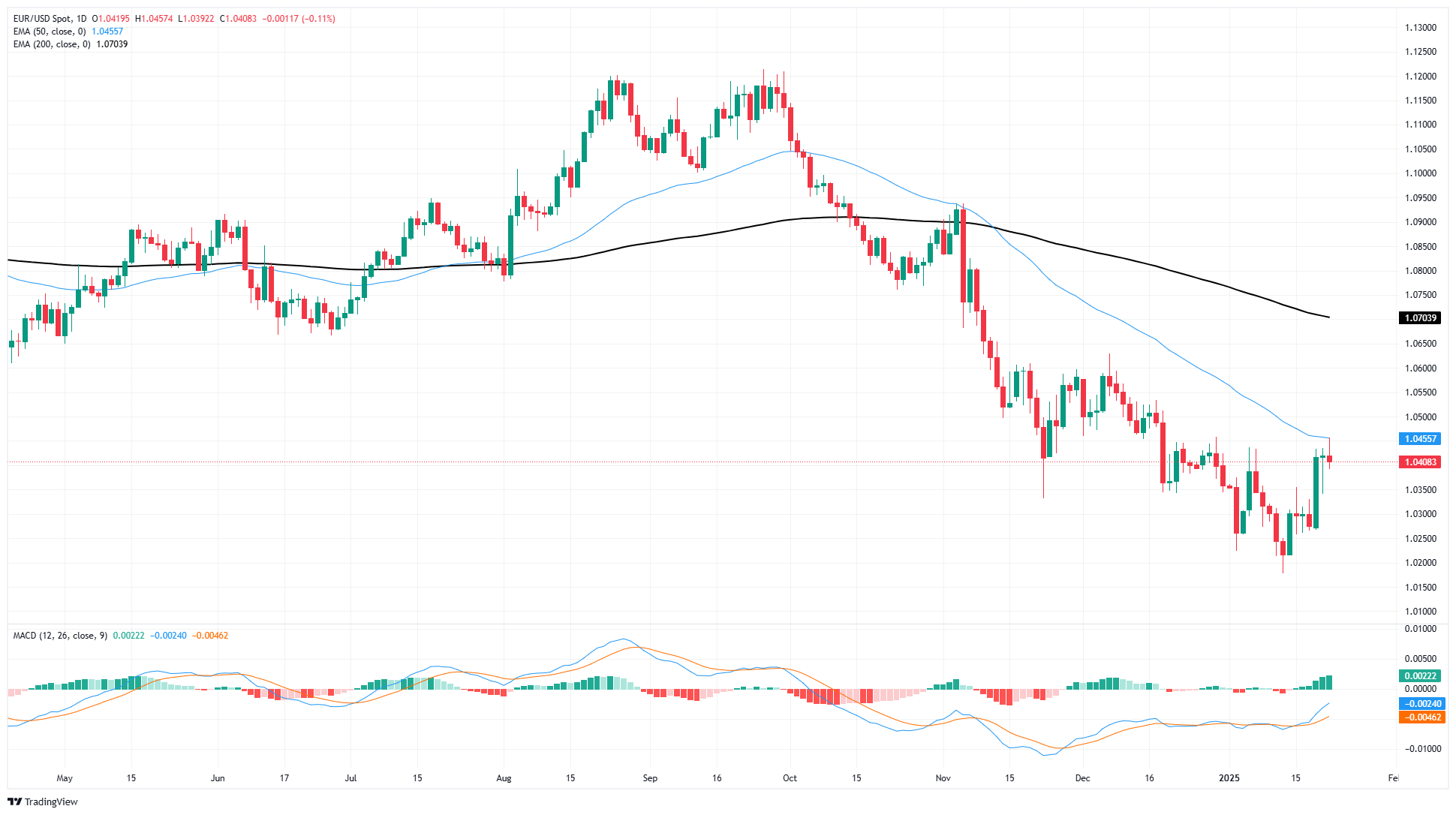EUR/USD halts recovery during midweek slowdown
- EUR/USD fell a scant tenth of a percent on Wednesday.
- Market flows are crumpling with little of note on the data docket.
- The usual flow of trade war rhetoric headlines has abated, PMI figures loom ahead.
EUR/USD stumbled on Wednesday, giving up around one-tenth of one percent as markets grind through a lull between the week’s key data prints. US President Donald Trump has briefly halted his steady stream of trade war rhetoric and threats to impose import taxes on his own citizens across the board, leaving markets with little else to focus on.
Thursday will open up with a thin data docket just like Wednesday, and the US Federal Reserve (Fed) has entered its usual blackout period ahead of next week’s rate call. The European Central Bank (ECB) doesn’t have to worry about such self-imposed insults, but there is little that policymakers can say at this point that will shift market perspectives meaningfully in either direction. ECB President Christine Lagarde made an appearance on Wednesday that went largely unnoticed.
Fiber traders will have to settle for focusing on Friday’s Purchasing Managers Index (PMI) figures due from both the EU and the US. Both EU and US PMI business activity survey results for January are expected to come in mixed this week. The services components expected to tick down, or in the EU’s case, hold flat, and manufacturing to recover, albeit slightly. PMI figures generally have a limited impact unless figures come in wildly out of sync with forecasts, but survey respondent rates tend to be on the low side, and the overall figures should be taken with a grain of salt.
EUR/USD price forecast
Fiber bulls ran out of gas just south of the 50-day Exponential Moving Average (EMA) near 1.0460, flubbing the 1.0450 level and sending bids back down into the 1.0400 handle. Near-term bullish momentum has steadily fizzled despite dragging price action back up 2.75% bottom-to-top from last week’s dip into fresh two-year lows below 1.0200.
Despite technical indicators rolling over into bullish signals after giving firm indications of prices hitting oversold territory, sustained momentum is proving elusive. Traders hoping for a longer-term bullish correction should wait for price action to confirm a higher low pattern before looking for technical signals to jump in.
EUR/USD daily chart
Euro FAQs
The Euro is the currency for the 19 European Union countries that belong to the Eurozone. It is the second most heavily traded currency in the world behind the US Dollar. In 2022, it accounted for 31% of all foreign exchange transactions, with an average daily turnover of over $2.2 trillion a day. EUR/USD is the most heavily traded currency pair in the world, accounting for an estimated 30% off all transactions, followed by EUR/JPY (4%), EUR/GBP (3%) and EUR/AUD (2%).
The European Central Bank (ECB) in Frankfurt, Germany, is the reserve bank for the Eurozone. The ECB sets interest rates and manages monetary policy. The ECB’s primary mandate is to maintain price stability, which means either controlling inflation or stimulating growth. Its primary tool is the raising or lowering of interest rates. Relatively high interest rates – or the expectation of higher rates – will usually benefit the Euro and vice versa. The ECB Governing Council makes monetary policy decisions at meetings held eight times a year. Decisions are made by heads of the Eurozone national banks and six permanent members, including the President of the ECB, Christine Lagarde.
Eurozone inflation data, measured by the Harmonized Index of Consumer Prices (HICP), is an important econometric for the Euro. If inflation rises more than expected, especially if above the ECB’s 2% target, it obliges the ECB to raise interest rates to bring it back under control. Relatively high interest rates compared to its counterparts will usually benefit the Euro, as it makes the region more attractive as a place for global investors to park their money.
Data releases gauge the health of the economy and can impact on the Euro. Indicators such as GDP, Manufacturing and Services PMIs, employment, and consumer sentiment surveys can all influence the direction of the single currency. A strong economy is good for the Euro. Not only does it attract more foreign investment but it may encourage the ECB to put up interest rates, which will directly strengthen the Euro. Otherwise, if economic data is weak, the Euro is likely to fall. Economic data for the four largest economies in the euro area (Germany, France, Italy and Spain) are especially significant, as they account for 75% of the Eurozone’s economy.
Another significant data release for the Euro is the Trade Balance. This indicator measures the difference between what a country earns from its exports and what it spends on imports over a given period. If a country produces highly sought after exports then its currency will gain in value purely from the extra demand created from foreign buyers seeking to purchase these goods. Therefore, a positive net Trade Balance strengthens a currency and vice versa for a negative balance.


